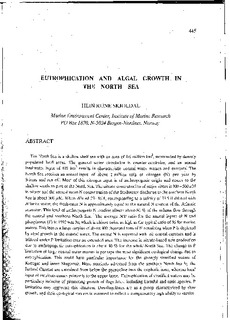| dc.description.abstract | The North Sea is a shallow shelf sea with an area of 0.6 million km^2, surrounded by densely
populated land areas. The general water circulation is counter-clockwise, and an annua1
freshwater input of 400 km^3 results in characteristic coastal water masses and currents. The
North Sea receives an annual input of about l million tons of nitrogen (N) per year by
3rivers and run-off. Most of this nitrogen input is of anthropogenic origin and comes to the
shallow southern part of the North Sea. The nitrate concentration of major rivers is 300-500 uM
in winter and the annual mean N concentration of the freshwater discharge to the southern North
Sea is about 300 uM. When diluted 23-fold, corresponding to a salinity of 33.5 if diluted with
Atlantic water, the freshwater N is approximately equal to the natural N content of the Atlantic
seawater. This level of anthropogenic N loading affects about 30 % of the volume flow through
the central and southern North Sea. The average NIP ratio for the annua1 inputs of N and
phosphorus (P) in 1990 was 30, which is almost twice as high as the typical ratio of 16 for marine
waters. This leaves a large surplus of about 400 thousand tons of N remaining when P is depleted
by algal growth in the coastal water. The excess N is exported with the coastal currents and is
utilized under P limitation over an extended area. The increase in nitrate-based new production
due to anthropogenic eutrophication is about 30 % for the whole North Sea. The change to P
limitation of large coastal water masses is perhaps the most significant ecological change due to
eutrophication. This could have particular importance for the strongly stratified waters of
Kattegat and inner Skagerrak. Here nutrients advected from the southern North Sea by the
Jutland Current are entrained from below the pycnocline into the euphotic zone, whereas local
input of nutrients comes primarily to the upper layer. Eutrophication of stratified waters may be
particulary inducive of promoting growth of flagellates, including harmful and toxic species. P
limitation may aggrevate this situation. Dinoflagellates are as a group characterized by slow
growth, and their ecological success is assumed to reflect a compensatory high ability to survive.
A relationship between P requirement and growth rate is postulated, reflecting the general
proportionality between content of nucleic acids and growth rate. Based on this, a hypothesis is
put forward that suggests a shift towards greater dominance of slow-growing algae, including red
tide dinoflagellates, with increasing NIP ratio of marine systems. Recent blooms of toxic
Prymnesiophytes, such as the 1988 bloom of Chrysochromulina polylepis in Kattegat and
Skagerrak, suggest amother link between P limitation and harmful algae. Prymnesiophytes seem
to have a good ability to grow on organic P and to be good competitors under P limitation. It is
hypothesized that Chrysochromulina type algae are usually living in association with organic
marine snow aggregates which presumably are P limited microenvironments. Massive blooms of
these organisms may be exceptional events made more likely by changes due to eutrophication.
Increased nutrient loading and associated P limitation may cause changes in nutrient conditions
of macroscale coastal environments which resemble the conditions of their microscale habitats. | en |
